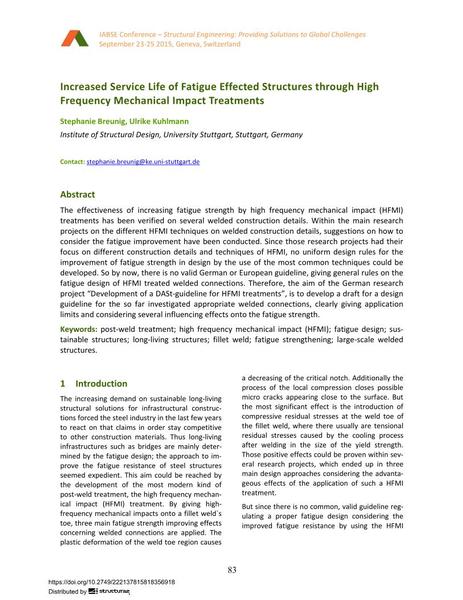Increased Service Life of Fatigue Effected Structures through High Frequency Mechanical Impact Treatments

|
|
|||||||||||
Bibliographic Details
| Author(s): |
Stephanie Breunig
(Institute of Structural Design, University Stuttgart, Stuttgart, Germany)
Ulrike Kuhlmann (Institute of Structural Design, University Stuttgart, Stuttgart, Germany) |
||||
|---|---|---|---|---|---|
| Medium: | conference paper | ||||
| Language(s): | English | ||||
| Conference: | IABSE Conference: Structural Engineering: Providing Solutions to Global Challenges, Geneva, Switzerland, September 2015 | ||||
| Published in: | IABSE Conference Geneva 2015 | ||||
|
|||||
| Page(s): | 83-90 | ||||
| Total no. of pages: | 8 | ||||
| Year: | 2015 | ||||
| DOI: | 10.2749/222137815818356918 | ||||
| Abstract: |
The effectiveness of increasing fatigue strength by high frequency mechanical impact (HFMI) treatments has been verified on several welded construction details. Within the main research projects on the different HFMI techniques on welded construction details, suggestions on how to consider the fatigue improvement have been conducted. Since those research projects had their focus on different construction details and techniques of HFMI, no uniform design rules for the improvement of fatigue strength in design by the use of the most common techniques could be developed. So by now, there is no valid German or European guideline, giving general rules on the fatigue design of HFMI treated welded connections. Therefore, the aim of the German research project “Development of a DASt-guideline for HFMI treatments”, is to develop a draft for a design guideline for the so far investigated appropriate welded connections, clearly giving application limits and considering several influencing effects onto the fatigue strength. |
||||
| Keywords: |
fatigue design fillet weld post-weld treatment high frequency mechanical impact (HFMI) sustainable structures long-living structures fatigue strengthening large-scale welded structures
|
||||
